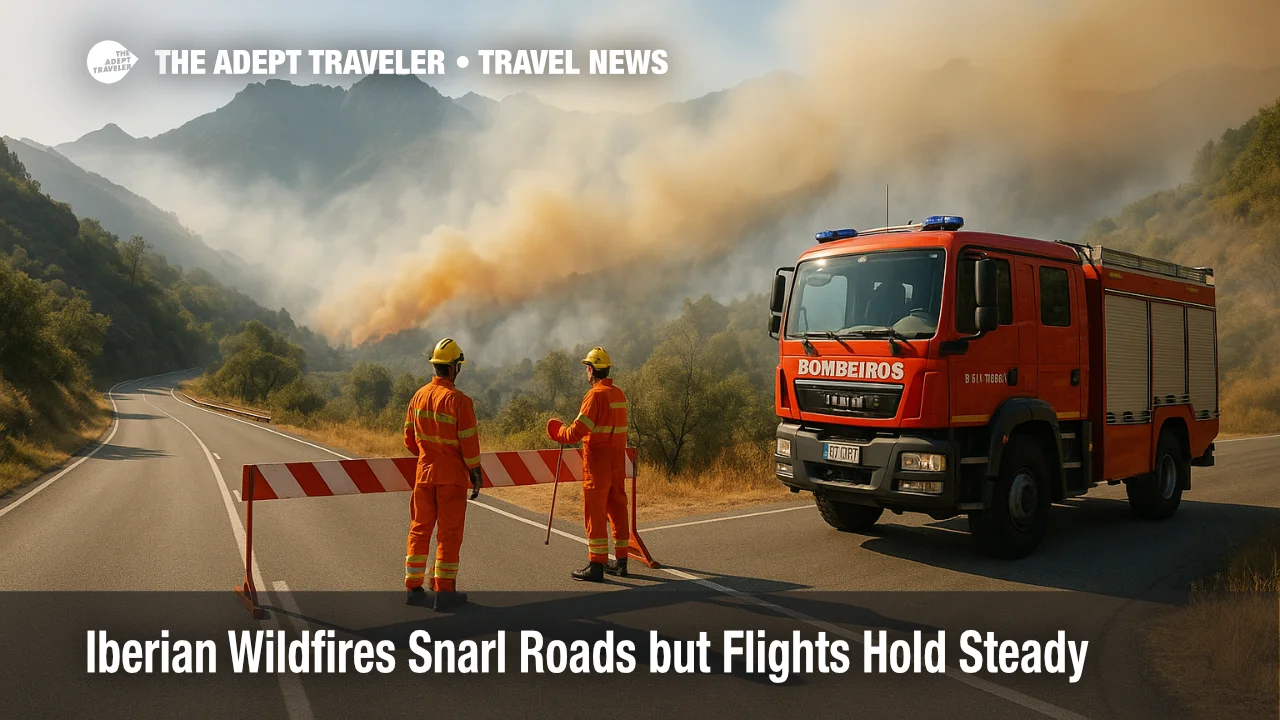Iberian Wildfires Snarl Roads but Flights Hold Steady

Wildfires burning across northern Portugal and central Spain are disrupting overland itineraries at the peak of the summer season. Firefighters have ordered rolling roadblocks, closed popular hiking routes, and evacuated several rural villages. For now, major airports and rail corridors remain open, and most airlines say operations are normal. Travelers heading to the Douro Valley, Peneda-Gerês National Park, and the Sierra de Gredos should prepare for detours, poor air quality, and last-minute schedule changes. Monitor local emergency channels, and keep flexible plans until crews declare the fires contained.
Key Points
- Why it matters: Road, trail, and village closures affect popular summer itineraries.
- Travel impact: A3, N103, and N-502 highways face rolling shutdowns; Paiva Walkways and other trails are off limits.
- What's next: Hot, windy weather over the weekend may spread flames and smoke toward new tourism zones.
- Civil-protection alerts dictate entry rules for Peneda-Gerês National Park.
- Madrid-Barajas, Porto, and Lisbon airports are operating normally, but visibility holds remain possible.
Snapshot
Roughly 2 000 Portuguese firefighters and 1 200 Spanish personnel are battling more than a dozen active blazes. Northern Portugal's largest fire, in the mountainous Arouca district, has burned through 7 400 acres and forced the closure of the scenic Passadiços do Paiva boardwalk. In Spain, flames near El Arenal in Ávila and Caminomorisco in Cáceres have consumed at least 6 000 acres combined. Temperatures topping 104 °F, low humidity, and gusty winds will keep the wildfire danger high through Monday. While commercial flights continue without major disruption, regional train services that hug the Douro River and peripheral bus routes in Ávila are running with speed restrictions or detours.
Background
Portugal and Spain share Europe's most fire-prone landscapes during July and August. Prolonged drought and record-hot Junes have primed Mediterranean pine and brush for rapid ignition. Portugal's worst fires since 2017 killed 66 people and burned 290 000 acres; subsequent reforms improved early-warning and evacuation protocols. Spain's Military Emergency Unit (UME) now supports civilian brigades whenever a blaze threatens critical infrastructure or populated valleys. Current fires erupted after three consecutive heatwaves pushed soil moisture below 10 percent. Civil-protection agencies issued red-flag warnings on July 29, and by dawn on July 31 both countries were battling level-two incidents in rugged terrain that hinders ground access.
Iberian Wildfires Latest Developments
Portugal: Park Closures Extend, Highway Detours Multiply
Fire commanders concentrated resources Friday on the Peneda-Gerês and Arouca fronts, where shifting winds at 25 mph complicated line construction. Access to Peneda-Gerês National Park remains suspended; checkpoints on the N203 near Lindoso turn away private cars and tour buses alike. The scenic N103 from Braga to Bragança is subject to convoy traffic control, adding up to 90 minutes to drives toward the Douro wine region. Porto (OPO) and Lisbon (LIS) airports reported no fire-related cancellations, yet ground delays of up to 20 minutes occurred when smoke briefly reduced visibility for inbound regional turboprops. Comboios de Portugal is running the Porto-Pocinho Douro line at reduced speed, and tickets are refundable only if the operator cancels a service. Travelers should carry photo ID, water, and masks, because officers may reroute traffic without notice and smoke concentrations can spike above 150 AQI in canyons.
Spain: Sierra de Gredos Trails Off Limits, N-502 Reopens Intermittently
In central Spain, UME reinforcements helped stabilize the Avila fire line overnight, but flare-ups continue west of El Arenal. The N-502 reopened at dawn, then closed again for two hours when dense smoke cut visibility below 50 yards-expect similar on-off controls through the weekend. Authorities lifted the shelter-in-place order for Mombeltrán, yet hikers are barred from western Sierra de Gredos trails until crews inspect footbridges and signage for damage. Renfe's long-distance trains to Madrid remain punctual, though several rural bus operators have diverted to alternate valleys, extending ride times by 30-60 minutes. The Cáceres blaze near Caminomorisco is 80 percent contained, allowing most residents to return. Air quality in Madrid peaked at a moderate 65 AQI Friday morning, posing little risk to healthy travelers, but carry FFP2 masks if visiting higher-altitude lookouts where smoke pools overnight.
Analysis
For air travelers, the good news is that Iberian wildfires rarely force outright airport closures; prevailing winds push smoke laterally, and modern instrument approaches allow safe landings in marginal visibility. The greater risk lies on the ground. Portugal's reliance on two-lane mountain highways means a single closure can strand motorists for hours, especially when fuel stations run low after detour traffic surges. Spain's more extensive expressway network helps, yet rural tourism-cottages, trailheads, and paradores-sits at the end of narrow roads that double as fire breaks. Travelers should therefore secure refundable accommodation, book rental cars with generous mileage, and monitor both Portuguese Proteção Civil and Spain's 112 service on social media. Travel insurance provides interruption coverage only when an evacuation or official closure blocks access to prepaid lodging. Voluntary itinerary changes are considered disinclination to travel, not force majeure. Those planning wine-region cruises or Douro rail excursions should build extra layover nights in Porto, allowing schedules to absorb same-day cancellations. In short, flexibility, real-time information, and respiratory precautions are the keys to safe mobility during the Iberian wildfires.
Final Thoughts
Wildfire seasons are now a recurring part of Iberian summers, and 2025 is no exception. By tracking local alerts, allowing buffer days, and carrying basic smoke protection, travelers can still enjoy Portugal's river valleys and Spain's mountain towns without undue risk. Pack patience, plot multiple routes, and be ready to pivot-those habits will keep your plans intact, even amid the unpredictable path of the Iberian wildfires.
